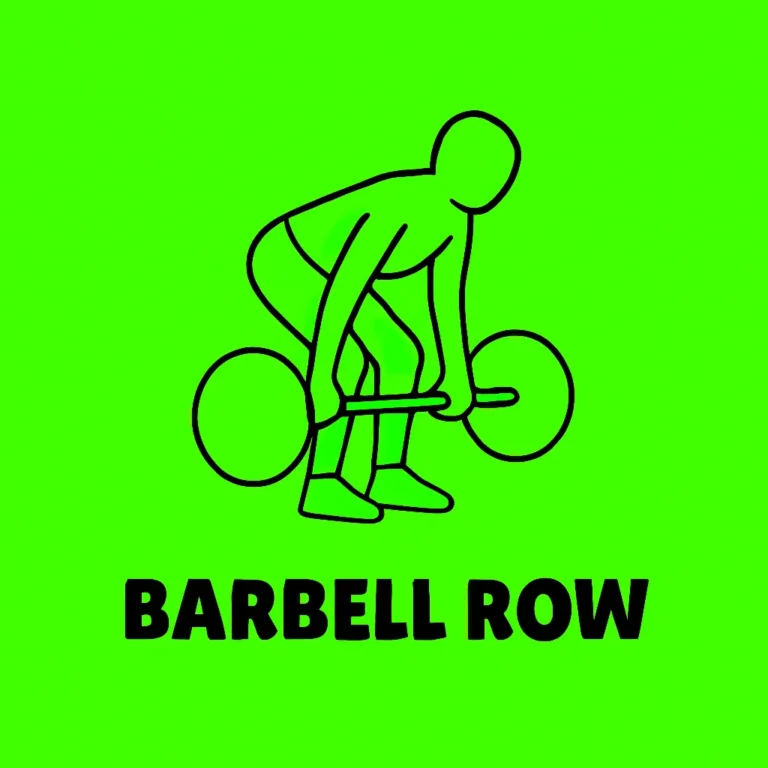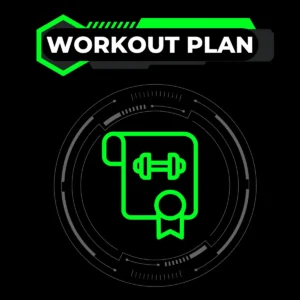The Barbell Row is one of the most effective exercises for developing strength in the upper body, specifically targeting the back muscles. This compound movement works multiple muscle groups simultaneously, making it an essential part of strength training programs. Whether you’re a beginner or an advanced lifter, mastering the barbell row will help you build strength, improve posture, and boost your overall athletic performance.
In this article, we’ll explore the various benefits of the Barbell Row, provide detailed instructions for executing it correctly, and look at common variations and mistakes. By the end, you’ll have a comprehensive understanding of how to incorporate this powerful exercise into your workout routine.
| Category | Details |
| Target Muscle Group | Back (Latissimus Dorsi, Rhomboids, Trapezius) |
| Exercise Type | Strength Training |
| Equipment Needed | Barbell and Weight Plates |
| Force Type | Pull |
| Training Level | Beginner to Advanced |
| Supporting Muscles | Biceps, Rear Shoulders (Posterior Deltoid), Lower Back |
| Mechanics | Compound |
Primary Muscle Groups Worked in Barbell Row
The Barbell Row primarily engages several key muscle groups in the upper body. Let’s break down the primary muscles that are targeted during the movement:
Upper Back (Rhomboids, Trapezius)
The rhomboids and trapezius muscles, located in the upper back, are the primary muscles worked during a barbell row. These muscles are responsible for scapular retraction, which is the action of pulling your shoulder blades back towards your spine. A strong upper back is essential for good posture and preventing injuries.
Lats (Latissimus Dorsi)
The latissimus dorsi, commonly known as the lats, are engaged as you pull the barbell towards your torso. These large muscles on either side of your back play a key role in shoulder extension and help in achieving the “V-shape” look that many athletes and bodybuilders desire.
Rear Deltoids
The rear deltoids, or posterior deltoids, are worked during the barbell row to a lesser degree. These muscles, located at the back of your shoulders, assist in shoulder extension and help stabilize the shoulder joint during the rowing motion.
Secondary Muscle Groups Engaged in Barbell Row
In addition to the primary muscles mentioned, the Barbell Row also recruits several secondary muscle groups to support the movement.
Biceps
As a pulling movement, the biceps play an important role in the barbell row. Although the focus is on the back, your biceps are actively engaged as they assist in flexing the elbow to bring the barbell towards the body.
Core Stability
Maintaining proper form during the Barbell Row requires core stability. The rectus abdominis, obliques, and erector spinae work to stabilize the torso, preventing excessive rotation and supporting the spine during the lifting process. A strong core is vital for overall strength and injury prevention.
Instructions Performing the Babrbell Row
Executing the Barbell Row with proper form is crucial to maximizing its effectiveness and avoiding injury. Here’s a step-by-step guide to performing the movement correctly:
- Starting Position
- Stand with your feet shoulder-width apart, holding a barbell with both hands. Your palms should be facing down (pronated grip).
- Slightly bend your knees and hinge forward at the hips, ensuring your back remains straight and flat. Your torso should be roughly parallel to the ground.
- Hold the barbell with your hands positioned just outside of your legs.
- The Pull
- Begin the movement by pulling your elbows straight back, keeping them close to your body.
- As the barbell moves upward, focus on squeezing your shoulder blades together, contracting the muscles in your upper back.
- The barbell should come up towards your lower chest or upper stomach, depending on your body position.
- Lowering the Barbell
- After reaching the peak of the movement, slowly lower the barbell back to the starting position while maintaining control.
- Keep your core engaged and your back neutral throughout the motion to avoid unnecessary strain.
- Repeat
- Perform the desired number of repetitions, ensuring you maintain proper form and controlled movements throughout the set.
The above description applies to the overhand variation. For other variations, please refer to the Variations of the Barbell Row.
Benefits of the Barbell Row
The Barbell Row offers numerous benefits, both in terms of muscle development and overall health. Here are some key benefits of incorporating this exercise into your routine:
Enhancing Back Strength
The barbell row is highly effective in building back strength, especially in the upper back, lats, and traps. A stronger back supports better posture, reduces the risk of injuries, and aids in other lifts, such as deadlifts and overhead presses.
Improving Posture and Muscle Tone
By strengthening the upper back and shoulders, the Barbell Row helps to counteract the effects of poor posture caused by sitting for extended periods. Regular practice can improve posture and create a more defined, muscular back.
Increasing Core Strength
While it primarily targets the back, the barbell row also engages the core muscles for stabilization. Over time, this leads to improved core strength, which is essential for all movements involving the torso, from athletic performance to daily activities.
Variations of the Barbell Row
There are several variations of the Barbell Row that can target the muscles in slightly different ways and offer variety to your training:
Underhand Grip Row
In this variation, you use an underhand grip (palms facing up) instead of the traditional overhand grip. The underhand grip places more emphasis on the biceps and the lower lats.
Pendlay Row
The Pendlay row is a strict version of the barbell row in which you start each repetition from the floor. The movement is performed explosively, with the barbell being pulled from a dead stop on the ground to reduce momentum and focus on the back muscles.
Single Arm Row
In this variation, you perform the row with one arm at a time, usually using a dumbbell or barbell. This allows for greater focus on each side of the body and can help to correct muscle imbalances.
Common Mistakes to Avoid in Barbell Row
While the Barbell Row is an incredibly effective exercise, it is easy to make mistakes that can reduce its effectiveness or lead to injury. Let’s take a look at some of the most common errors and how to avoid them:
Using Excessive Weight
One of the most common mistakes people make when performing the Barbell Row is using too much weight. While it can be tempting to load up the barbell with heavy weights, this often results in poor form and reduced control. Lifting too heavy can lead to swinging the body or jerking the barbell, which increases the risk of injury. To avoid this, start with a manageable weight and focus on perfecting your form before gradually increasing the load.
Poor Form and Technique
Maintaining proper form is crucial to getting the most out of the barbell row and preventing injury. A common mistake is rounding the back or hunching the shoulders while rowing the barbell. This can place unnecessary strain on the spine and lower back muscles, potentially leading to serious injuries. Always keep your back straight, with a neutral spine, and avoid using momentum to lift the weight.
Another mistake is allowing the elbows to flare out too much during the movement. This reduces the engagement of the back muscles and shifts the focus onto the shoulders. Make sure to keep your elbows close to your body throughout the row.
Neglecting Proper Warm-up
Skipping the warm-up before performing heavy lifts can lead to muscle strains and other injuries. The Barbell Row is a demanding movement that requires your muscles and joints to be properly prepared. Perform dynamic stretches and warm-up sets with lighter weights before jumping into your working sets. This will improve your range of motion and activate the muscles you will be using during the row.
Safety and Precautions in Barbell Row
Safety is paramount when performing any strength training exercise, especially with compound movements like the Barbell Row. Here are some important safety tips to follow:
Importance of Warm-up and Stretching
Before beginning your workout, make sure to warm up properly to prevent injuries. A good warm-up routine should include light cardiovascular activity (such as jogging or cycling) followed by dynamic stretches to activate the muscles involved in the Barbell Row. This will increase blood flow and improve joint mobility, making your workout safer and more effective.
Avoiding Overtraining
Overtraining is a risk when performing compound exercises, especially if you’re lifting heavy weights. It’s essential to allow your muscles to recover between sessions. If you’re training the back frequently, make sure to include rest days in your routine to prevent overuse injuries and muscle fatigue.
Equipment Needed for Barbell Row
To perform the Barbell Row, you’ll need a few essential pieces of equipment:
Barbell and Plates
A standard barbell with weight plates is the primary equipment for the Barbell Row. Make sure the barbell is of appropriate length and can hold enough weight for your current strength level. For beginners, start with lighter plates and gradually increase the load as you progress.
Weightlifting Belt (Optional)
While not mandatory, a weightlifting belt can provide additional support for your lower back, especially when lifting heavier weights. It helps maintain core stability and protects the spine during the lift. However, it’s essential not to rely on a belt for every set – focus on building core strength as well.
Proper Footwear
Proper footwear is essential to provide stability and support while lifting. Wear flat, non-compressive shoes, such as lifting shoes or cross-training shoes, to ensure that you have a stable base when performing the Barbell Row. Avoid wearing running shoes or shoes with cushioned soles, as these can cause instability during the movement.
Alternative Exercises instead of Barbell Row
If you’re looking to add variety to your workout or need an alternative to the Barbell Row, there are several exercises that target similar muscle groups. Here are a few options:
Dumbbell Rows
The Dumbbell Row is a great alternative to the Barbell Row and can be done with a single dumbbell. It allows for a greater range of motion and isolates each side of the back. Dumbbell rows can be performed one arm at a time, which can help correct imbalances in strength between the two sides of the body.
Seated Cable Row
The Seated Cable Row is another excellent alternative that targets the same back muscles. This exercise involves sitting on a machine and pulling a cable towards your torso, similar to the motion of a barbell row. The seated cable row provides constant tension throughout the entire movement, which can help with muscle growth.
T-Bar Row
The T-Bar Row is performed using a T-bar machine or landmine attachment. This variation allows you to lift heavy weights while maintaining a stable torso position. It’s an excellent option for building thickness in the back and increasing overall strength.
Other Names for the Barbell Row
The Barbell Row is also known by several other names, depending on the variation or regional preferences. Some of the common alternative names include:
Bent-Over Row
The Bent-Over Row is a general term often used to refer to any type of row where the lifter bends at the hips to pull the weight towards their torso. It can refer to the barbell row or other variations.
Barbell Bent-Over Row
This is the full name of the exercise when specifically referring to the barbell variation, emphasizing the body position (bent-over) and the equipment used (barbell). It is often used interchangeably with the term “Barbell Row.”
If you’re looking for more exercises to strengthen your back muscles, be sure to check out our back library. You’ll find comprehensive guides, workout plans, and expert tips to help you take your progress to the next level!
For a complete collection of exercises targeting all muscle groups, visit our Exercise Library. Explore detailed guides and focused workouts to improve your performance and fitness journey!
Enhance Your Back Training: Must-Read Resources
The barbell row is a powerful compound exercise for developing your back muscles, particularly targeting the latissimus dorsi, rhomboids, and traps. To gain deeper insights into back muscle anatomy and movement mechanics, check out this comprehensive guide on ExRx.net.
For those interested in refining their technique and exploring variations, expert advice and training tips are available on Bodybuilding.com. Whether you’re a beginner or an advanced athlete, this resource is tailored to improve your rowing technique.
Proper form and safety are essential for avoiding injury during this heavy movement. Learn more about exercise safety and guidelines from the trusted Mayo Clinic.



